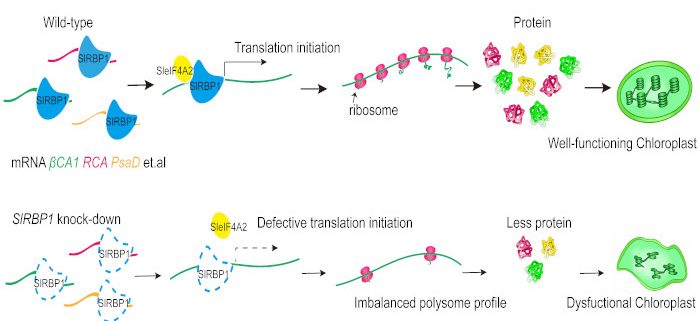Chloroplast in Translation: How the tomato RNA-binding protein SlRBP1 regulates translation of nuclear transcripts that encode chloroplast proteins
Background: The nuclear genome encodes most of the proteins that are found in chloroplasts; these proteins are translated in the cytoplasm and imported into the chloroplast. The finely tuned regulation of these nuclear transcripts encoding chloroplast-localized proteins is crucial for chloroplast function. Numerous RNA-binding proteins (RBPs) that regulate nuclear-encoded chloroplast transcripts have been identified in Arabidopsis, rice, and maize; however, the tomato RBPs directly involved in the translation of RNA targets remain largely unknown.
Question: How does the nucleus-encoded protein SlRBP1 specifically control its targets to maintain chloroplast function during tomato growth and development?
Findings: Loss-of-function of SlRBP1 caused dwarf tomato plants with yellow leaves and downregulated photosynthesis, and fruits of different shades of yellow and orange, indicating that SlRBP1 is important for chloroplast function. Moreover, silencing of SlRBP1 dramatically decreased the translation efficiency of its target mRNAs, nuclear transcripts encoding key photosynthesis-related, chloroplast-targeted proteins. This resulted in a dramatic reduction in the accumulation of the proteins encoded by its target mRNAs. SlRBP1 interacts with the eukaryotic translation initiation factor SleIF4A2 and promotes its association with RNA targets. Based on these observations, we propose a model for translational regulation of chloroplast functions by SlRBP1.
Next steps: As RNA structure is important for the binding of RBPs to their target RNA, our future work will investigate the specific secondary structures of target RNAs for the binding of SlRBP1 and explore how SlRBP1 and SleIF4A2 bind in concert to mRNAs to regulate translation.
Reference:
Liqun Ma, Yongfang Yang, Yuqiu Wang, Ke Cheng, Xiwen Zhou, Jinyan Li, Jingyu Zhang, Ran Li, Lingling Zhang, Keru Wang, Ni Zenga, Yanyan Gong, Danmeng Zhuc, Zhiping Deng, Guiqin Qu, Benzhong Zhu, Daqi Fu, Yunbo Luo, Hongliang Zhu (2022) SlRBP1 promotes translational efficiency via SleIF4A2 to maintain chloroplast function in tomato. https://doi.org/10.1093/plcell/koac104




